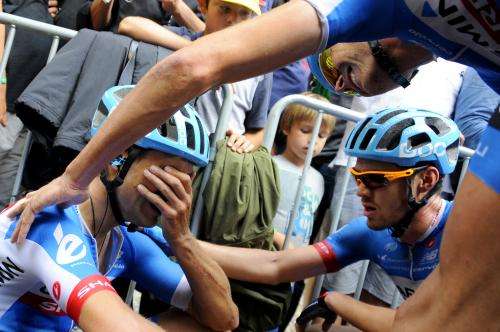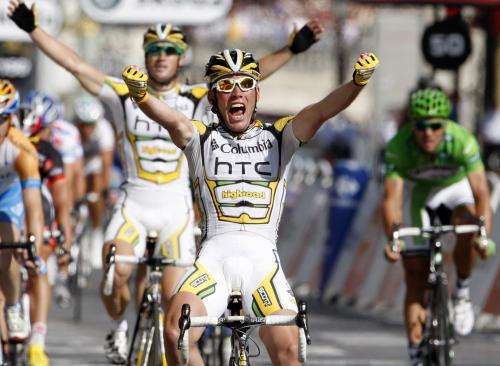How to win a Tour de France sprint

The final dash to the line in a Tour de France sprint finish may appear to the bystander to be a mess of bodies trying to cram into the width of a road, but there is a high degree of strategy involved. It takes tactics, positioning and, ultimately, power.
The perfect sprint
In a perfect race, the best execution of a sprint win does not always come down to one rider. It is often the result of the work of teammates too. The back story to a winning sprint may have started hours before the finish line is in sight.
During the stage, riders who have little chance in the finale will try their luck to beat the pack by being part of a "breakaway" – they jump clear of the peloton and then hope to outrun the others to the line. But if any team wants the stage to end in a mass sprint, it will check the speed of this breakaway and typically calculate how quickly the riders in it could be reeled in. Catch them too soon and new attacks may go clear (meaning more work for the interested teams to chase down), leave it too late and the breakaway wins. In stage 15, this approach got tested when New Zealand rider Jack Bauer spent all day in the breakaway. He finally was caught just 20 metres from the finish line by the sprinters. The sport can sometimes be very cruel.
Commentators typically suggest that on flat terrain, the ideal controllable gap is roughly one minute per 10 kilometres between a breakaway and the chasing pack. Towards the end of a stage, the interested teams supply riders to power into the wind and slowly close this gap down. The breakaway should then hopefully be caught with a handful of kilometres left to go.
At this point, the sprint-orientated teams deploy what is known as a leadout "train". This train is made up of as many riders as possible from the same team. Each team member on the front then rides at a maximum effort before peeling off. The team's designated sprinter is at the back of this train and is intentionally sheltered by the efforts of those riding in front to save his energy. It has been demonstrated that with four cyclists riding in a line, a rider positioned four men back only has to produce 64% of the power of the rider at the very front.

The penultimate rider in a sprint train is referred to as the leadout. This person puts in the last effort to position the sprinter sheltering behind. Ideally, the sprinter is then finally only exposed at the front with around 200 metres to go. When this happens, a winning sprinter like Mark Cavendish will cover this final portion in around 11 seconds.
Freelancing
If a sprinter doesn't have the use of a leadout train – which does happen – he can "freelance". This makes the opposition teams do the work before the sprinter leapfrogs around the group, hopefully ending up directly behind another sprinter with enough time to beat him to the finish line. In this case, a sprinter from one team effectively becomes the leadout for another.
On some occasions, no single team is able to control the final run to the line at all. From the air, the shape of the peleton in this case becomes broad at the front and spread across the full width of the road. When this happens, the chances of crashes are higher as rival leadout trains jostle for position and riders leap from wheel to wheel looking for shelter.
First week desperation

Crashes normally occur when riders touch the wheels of other riders around them or lose control of their bicycles. In stage one this year, aggression played a part as Mark Cavendish and Australian Simon Gerrans battled to follow the wheel of Slovakian sprinter Peter Sagan. Sometimes riders realise they have nowhere to go and have to delay their sprint or wait for a gap to open up. Some opt for more punchy tactics though, using shoulders, elbows or heads to force gaps to open up between them and other riders. In stage one, Cavendish was boxed in, tried to force his way out and took both men down.
One of the most dramatic examples of a sprint crash is the first stage in the 1994 event when a policeman who was manning the finish straight barriers decided to lean out to take a photo of the finish.
Ultimately the perfect sprinter is a rider who expends as little energy as possible on the day, is deposited by others in the right place at the right time and has the ability to make fast judgement calls as the shape of the peloton changes around them. Marcel Kittel and his Giant Shimano team have shown everyone else how it's done so far in 2014, but the prestige sprint stage on the Champs Élysées this weekend will give his rivals (Cavendish excepted) a final chance to put the theory into practice.
Source: The Conversation
This story is published courtesy of The Conversation (under Creative Commons-Attribution/No derivatives).
![]()




















